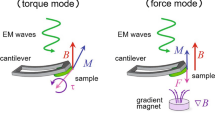Abstract
A new combination of three-point bending stress and electron spin resonance (ESR) methods was developed and successfully tested in the field of glassy and ceramic materials. Summarizing the observed phenomena, one can establish the following advantages of such an experimental combination: (i) direct and continuous observation of the material under the action of bending stress up to mechanical destruction of the sample; (ii) optically transparent samples are not necessary, but a further direct combination with optical methods is, in general, possible; (iii) the high sensitivity and selectivity of the ESR method allow the first steps of stress influence on the local geometry to be followed long before the crack appears and fracture takes place, respectively; (iv) local effects are observed on the atomic scale which can be related to the mechanical properties by an appropriate hamiltonian; (v) the reversibility of the effects can easily be proved by a suitable alternating stress/relaxation regime; (vi) variation of further parameters such as temperature or application of tensile stress, is possible.
Similar content being viewed by others
References
R. Stösser, M. Nofz, R. Brenneis, J. Klein and A. Rericha, Mater. Sci. Forum 62–64 (1990) 279.
R. Stösser, J. Klein, M. Nofz, R. Lück, A. Rericha and R. Brenneis, High Press. Res. 7 (1991) 279.
M. Nofz and R. Stösser, Silikattechnik 41 (1990) 310.
R. Stoesser, K. Maeder, H.-H. Borchert and R. Lueck, High Press. Res. 13 (1994) 29.
R. Stoesser and R. Brenneis, ibid. 13 (1994) 71.
R. Stösser, R. Brenneis and I. Ebert, J. Mater. Sci. 25 (1990) 223.
R. S. De Biasi and D. C. S. Rodrigues, ibid. 2 (1983) 210.
V. Beltran-Lopez, J. Castro-Tello, J. Magn. Res. 39 (1980) 437.
J. Klein, Thesis, Humboldt-Universlty, Department of Chemistry, Berlin (1990).
R. Stösser, High Press. Res. 9 (1992) 259.
R. Stösser, R. Brenneis, W. Herrmann and N. Steinfeldt, in “Hocheistungskeramik”, edited by G. Petzow, F. Tobolski and R. Telle (VCH Verlagsgesellschaft m.b.H., Weinheim, 1995) pp. 281–97.
W. Schulle, in “Feuerfeste Werkstoffe” (Deutscher Verlag für Grundstoffindustrie m.b.H., Leipzig, 1990) pp. 68–79, 101–121 and 211–220.
R. Lück, R. Stösser and H. Rager, High Press. Res. 7 (1991) 287.
R. Brenneis, R. Stößer and W. Herrmann, (unpublished data).
Author information
Authors and Affiliations
Rights and permissions
About this article
Cite this article
Stoesser, R., Steinfeldt, N., Brenneis, R. et al. Electron spin resonance in situ observation of the bending stress process in corundum materials and glasses. JOURNAL OF MATERIALS SCIENCE 31, 1405–1413 (1996). https://doi.org/10.1007/BF00357846
Received:
Accepted:
Published:
Issue Date:
DOI: https://doi.org/10.1007/BF00357846




